Highlights
May 2018
PRB publication selected by Editors as “Editors’ suggestion"
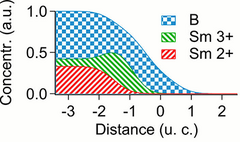
SmB6 is a mixed-valence, strongly correlated Kondo insulator. Moreover, its band structure makes it a promising contender in the quest for one of the first systems with topologically nontrivial and correlated surface states. Despite the “topological protection”, surface layer reconstructions can fundamentally change the material’s properties, so that the topological state is expelled into the undisrupted bulk. Following previous indications, the authors combine resonant reflectivity, photoemission, and theory to uncover chemical and valence reconstruction and its dynamics, resulting in boron termination and Sm3+ subsurface dominance. This work reconciles earlier studies using more surface-sensitive techniques, such as photoemission and scanning tunneling spectroscopy. Phys. Rev. B 97, 205416 (2018)
October 2017
Master student Katrin Fürsich awarded the “Bayerische Ingenieurinnen-Preis"
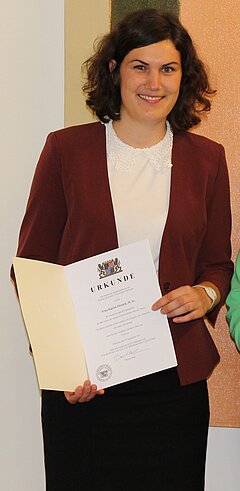
Katrin Fürsich, who performed her Master thesis in our group, studying transition-metal oxide nanolayers with resonant x-ray reflectometry, has received the “Bayerische Ingenieurinnen-Preis”. Congratulations, Katrin! more
May 2013
Former group member becomes Junior Professor

Dmytro Inosov, longstanding collaborator and former group member, was appointed Junior Professor at the University of Dresden in May 2013. Dima applies neutrons scattering to correlated material systems, in particular the iron pnictides. Congratulations, Dima!
April 2013
Moving to the University of Würzburg

At the beginning of 2013, Vladimir Hinkov, head of the group, was appointed Associate Professor at the University of Würzburg and we subsequently moved to beautiful Würzburg, after 2.5 years at the Max-Planck-UBC Centre of Quantum materials in beautiful Vancouver, British Columbia. We keep a close collaboration both with the University of British Columbia and with the Max-Planck Institute in Stuttgart.
November 2012
"Exchange-spring"-like structure observed in correlated oxide superlattice
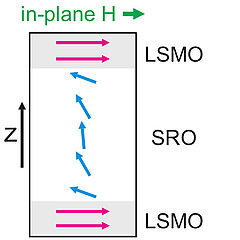
Superlattices composed of different magnetic materials with disticnt magnetic coupling mechanisms at the interface hold promise of revealing novel phenomena and functionalities. La0.7Sr0.3MnO3 and SrRuO3 are both complex, ferromagnetic oxides. We have studied their magnetization profiles using spin-polarized neutron reflectometry supported by resonant x-ray scattering and magnetometry.Our investigations show a noncollinear spin configuration with the orientation of the Ru moments changing from in-plane at the interface to out-of-plane deep inside the SrRuO3 layers. This unusual spin structure is owed to the competition between two distinct mechanisms: On the one hand, the antiferromagnetic exchange coupling of Mn and Ru ions dictate an antiparallel, in-plane moment alignment in the vicinity of the interface. On the other hand, the magnetocrystalline anisotropy of the Ru moments warrant a rotation of the Ru moments into an out-of-plane orientation away from the interface. The phenomenon we report is related to the exchange spring structures observed in simpler multilayers composed of ferromagnetic elements and alloys, one can bring together a (hard) of high coercivity in contact with a (soft) magnet of high saturation magnetization to obtain a new material with enhanced properties called an exchange spring magnet: The two magnetic phases interact at the interface through exchange coupling. When a gradually increasing external field is applied, the magnetically softer material will first follow the orientation of the field within its bulk, whereas the hard material will keep the original magnetization orientation and induce a near-interface region with gradually twisting moment orientation. In contrast to the spring exchange effect in conventional magnetic structures, the interfacial coupling in our structures is antiferromagnetic, and consequently, no external magnetic field is necessary to reveal the effect. Furthermore, the magnetocrystalline anisotropy provides an intrinsic, non-collinear direction. These additional degrees of freedom allow us to tailor the properties of our system in a wider range as compared to conventional spring exchange systems.
[1] J.-H. Kim, V. Hinkov et al., Phys. Rev. B (Rapid Communications) 86, 180402 (2012)
exchangeSpring
August 2012
The ferromagnetic LaCoO3 conundrum solved? Strain-relaxing structural modulation induces sheets with Cobalt in intermediate or high spin configuration
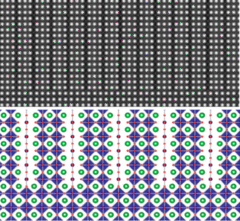
In oxide multilayers, various symmetries of the bulk constituents are broken, resulting in a plethora of exotic phenomena like interfacial high-density 2D electron gases, magnetic and orbital reconstruction. However, the microscopic understanding of such phenomena requisite for manipulating their properties and creating novel functionalities is often lacking. A particular example is LaCoO3, a zero spin, non-magnetic material in the bulk, whose strong ferromagnetism as a thin film remains enigmatic despite a decade of intense research.
We have studied epitaxial LaCoO3 films on substrates imposing different degrees of strain and provide a surprisingly simple resolution: Z-contrast scanning transmission electron microscopy reveals an ionic distance modulation pattern which reduces the strain energy and entails the formation of ferromagnetically ordered sheets comprising intermediate or high spin Co3+. The average magnetic moment per cobalt ion as determined by magnetometry correlates with the sheet density. X-ray and ellipsometric spectroscopy provide evidence for a stoichiometric composition with a Co3+ population of at least 95%, lending further support to the described model and excluding oxygen vacancy ordering as a major driving force of the observed modulation.
The reported modulation also constitutes a novel, controlled strain relaxation mechanism which does not involve defects or misfit dislocations. This is important for applications when keeping in mind which catastrophic impact such imperfections have on device performance.
[1] Woo Seok Choi et al., Nano Letters DOI:10.1021/nl302562f
May 2012
Martin Bluschke, master student of the group, graduates with distinction
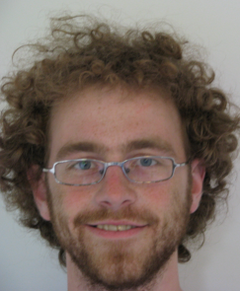
Martin Bluschke, honours student at the UBC, graduated with distinction and obtained the mark A+ (94%). In his work "Orbital reconstruction at the surface of lanthanum nickelate thin films" he investigated multilayer structures comprising correlated, functional oxide materials. Martin's next step is a PhD thesis in the group of Bernhard Keimer at the Max-Planck Institute for Solid State Research in Stuttgart.
March 2011
Orbital reflectometry: Using soft x-rays to study orbital reconstruction in complex oxide heterostructures
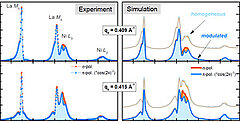
Transition-metal oxides (TMOs) are particularly sensitive to dimensionality effects, since the occupation of the five d-orbitals delicately depends on the electronic surroundings of individual transition-metal atoms. The orbital occupation balance in the bulk can be disturbed by deposition on lattice-mismatched substrates or by creating interfaces or surfaces. Hitherto available spectroscopic tools can hardly provide information about the interfacial electronic properties, in particular the orbital occupation: For instance, while conventional x-ray linear dichroism in absorption geometry can provide some insight into the orbital reconstruction at a single buried interface, relying on the different electron escape depth in the TEY and FY modes, it lacks any depth-resolved information.
Using resonant soft-x-ray reflectivity, we derive quantitative, spatially resolved orbital polarization depth profiles, without resorting to model calculations [1]. The method is sensitive enough to resolve differences of ~3% in the occupation of Ni eg orbitals in adjacent atomic layers of a LaNiO3-LaAlO3 superlattice (see Figure), in good agreement with theoretical calculations. The possibility to quantitatively correlate theory and experiment on the atomic scale opens up many new perspectives for orbital physics and device applications in transition-metal oxides.
[1] E. Benckiser et al., Nature Materials 11 (2011), 189-193
Orbital reflectometry yields quantitative, depth-resolved orbital polarization profiles of multilayers. The figure compares polarization-dependent reflectivity data for a LaNiO3-LaAlO3 superlattice (left) to the corresponding simulated curves (right) for a homogeneous and modulated (reconstructed) orbital occupation in the LaNiO3 layers: Assuming a modulation fits the data better.
March 2010
Orbital reflectometry: Using soft x-rays to study orbital reconstruction in complex oxide heterostructures
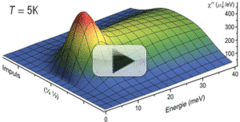
Transition-metal oxides (TMOs) are particularly sensitive to dimensionality effects, since the occupation of the five d-orbitals delicately depends on the electronic surroundings of individual transition-metal atoms. The orbital occupation balance in the bulk can be disturbed by deposition on lattice-mismatched substrates or by creating interfaces or surfaces. Hitherto available spectroscopic tools can hardly provide information about the interfacial electronic properties, in particular the orbital occupation: For instance, while conventional x-ray linear dichroism in absorption geometry can provide some insight into the orbital reconstruction at a single buried interface, relying on the different electron escape depth in the TEY and FY modes, it lacks any depth-resolved information.
Using resonant soft-x-ray reflectivity, we derive quantitative, spatially resolved orbital polarization depth profiles, without resorting to model calculations [1]. The method is sensitive enough to resolve differences of ~3% in the occupation of Ni eg orbitals in adjacent atomic layers of a LaNiO3-LaAlO3 superlattice (see Figure), in good agreement with theoretical calculations. The possibility to quantitatively correlate theory and experiment on the atomic scale opens up many new perspectives for orbital physics and device applications in transition-metal oxides.
[1] E. Benckiser et al., Nature Materials 11 (2011), 189-193

